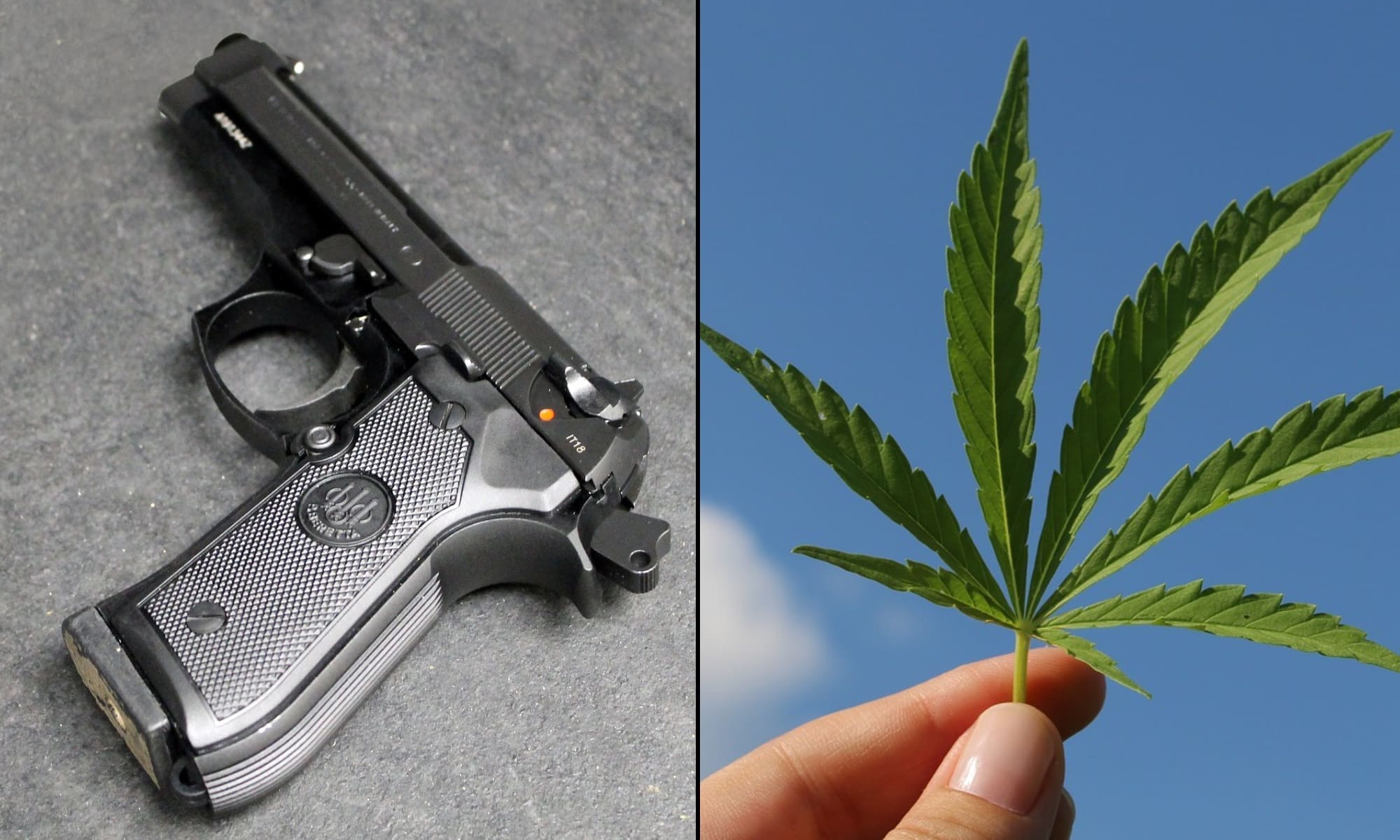featured
Trump DOJ Asks Supreme Court For Delayed Schedule In Case On Marijuana Users’ Gun Rights
Published
7 hours agoon

The Justice Department is asking the U.S. Supreme Court for more time to submit briefs in a case justices recently agreed to hear that concerns the constitutionality of a federal ban on gun ownership by people who use marijuana and other drugs.
In a motion from the Trump administration that was sent to the court on Thursday, DOJ said there was mutual agreement between its attorneys and those representing the respondent in the case that the current deadline for briefs and reply briefs should be revised because of the “press of other cases.”
Currently, the Justice Department is supposed to file its first brief with the court by December 4, but it’s requesting that be extended to December 12. That would push the respondent’s deadline to submit a brief to January 20.
“If those extensions are granted, the reply brief would be due on February 19, 2026. Both parties consent to this briefing schedule,” U.S. Solicitor General D. John Sauer, an appointee of President Donald Trump, said in the motion.
The Trump administration has routinely argued that the policy restricting gun ownership by people who use cannabis, even in compliance with state law, “targets a category of persons who pose a clear danger of misusing firearm” and should be upheld.
After several years of conflicting lower court rulings on related cases, justices on Monday granted cert in U.S. v. Hemani to settle the question of whether the ban—known as Section 922(g)(3)—is consistent with the Second Amendment.
While the court on Monday also declined to take up a separate case on cannabis consumers’ gun rights, there are still several others pending a decision from the justices. But the choice to take up Hemani in particular is likely welcome news to the Justice Department, which has consistently defended the firearm prohibition and specifically requested that SCOTUS review that case instead of alternatives.
That could be related to the fact that the defendant is not only a marijuana consumer but also a user of cocaine who’s sold drugs in the past, so it’s possible DOJ reasoned that he is a less sympathetic face for the issue. Defendants in the other cases were merely found in possession of both a firearm and marijuana.
In June, the solicitor general submitted a filing with the Supreme Court that said “Section 922(g)(3) complies with the Second Amendment,” and the statute “targets a category of persons who pose a clear danger of misusing firearms: habitual users of unlawful drugs.”
The law “bars their possession of firearms only temporarily and leaves it within their power to lift the restriction at any time; anyone who stops habitually using illegal drugs can resume possessing firearms,” Sauer said.
Notably, while the government mentions “habitual” users of illegal drugs 40 times in its filing, that word does not itself appear in 922(g)(3). The language of the statute prohibits anyone “who is an unlawful user of or addicted to any controlled substance” from purchasing or possessing firearms or ammunition.
In a separate August filing for the case, the Justice Department also emphasized that “the question presented is the subject of a multi-sided and growing circuit conflict.” In seeking the court’s grant of cert, the solicitor general also noted that the defendant is a joint American and Pakistani citizen with alleged ties to Iranian entities hostile to the U.S., putting him the FBI’s radar.
Now that the Supreme Court has agreed to take up Hemani, if justices declare 922(g)(3) constitutional, such a ruling could could mean government wins in the remaining cases. The high court on Monday denied a petition for cert in U.S. v. Cooper, while leaving pending decisions on U.S. v. Daniels and U.S. v. Sam. The justices were scheduled to discuss all of the cases at a closed-door meeting last Friday.
The court also recently denied a petition for cert in another gun and marijuana case, U.S. v. Baxter, but that wasn’t especially surprising as both DOJ and the defendants advised against further pursing the matter after a lower court reinstated his conviction for being an unlawful user of a controlled substance in possession of a firearm.
A number of federal courts in recent years have cast doubt on the legality of § 922(g)(3), finding generally that while the ban on gun ownership among drug users may not be entirely unconstitutional, there’s scant historical precedent for such a broad restriction of Second Amendment rights on an entire a category of people.
Meanwhile, in recent interviews with Marijuana Moment, several Republican senators shared their views on the federal ban on gun possession by people who use marijuana—with one saying that if alcohol drinkers can lawfully buy and use firearms, the same standard should apply to cannabis consumers.
Separately, the U.S. Court of Appeals for the Tenth Circuit last month sided with a federal district court that dismissed an indictment against Jared Michael Harrison, who was charged in Oklahoma in 2022 after police discovered cannabis and a handgun in his vehicle during a traffic stop.
The case has now been remanded to that lower court, which determined that the current statute banning “unlawful” users of marijuana from possessing firearms violates the Second Amendment of the Constitution.
The lower court largely based his initial decision on an interpretation of a Supreme Court ruling in which the justices generally created a higher standard for policies that seek to impose restrictions on gun rights.
The ruling states that any such restrictions must be consistent with the historical context of the Second Amendment’s original 1791 ratification.
The historical analogues that the Justice Department relied on to make the case that the ban is consistent included references to antiquated case law preventing Catholics, loyalists, slaves and Indians from having guns.
The circuit court, for its part, said that “the government must show non-intoxicated marijuana users pose a risk of future danger” to support the current policy. “This inquiry, which may involve fact finding, is best suited for the district court.”
Meanwhile, in the U.S. Court of Appeals for the Eleventh District, judges recently ruled in favor of medical cannabis patients who want to exercise their Second Amendment rights to possess firearms.
As a recent report from the Congressional Research Service (CRS) explained the current legal landscape, a growing number of federal courts are now “finding constitutional problems in the application of at least some parts” of the firearms prohibition.
In a recent ruling, a three-judge panel for the U.S. Court of Appeals for the Eighth Circuit vacated a defendant’s conviction and remanded the case back to a district court, noting that a retrial before a jury may be necessary to determine whether cannabis in fact caused the defendant to be dangerous or pose a credible threat to others.
The Third Circuit separately said in a published opinion that district courts must make “individualized judgments” to determine whether 922(g)(3) is constitutional as applied to particular defendants.
—
Marijuana Moment is tracking hundreds of cannabis, psychedelics and drug policy bills in state legislatures and Congress this year. Patreon supporters pledging at least $25/month get access to our interactive maps, charts and hearing calendar so they don’t miss any developments.![]()
Learn more about our marijuana bill tracker and become a supporter on Patreon to get access.
—
Earlier this year, a federal judge in Rhode Island ruled that the ban was unconstitutional as applied to two defendants, writing that the government failed to establish that the “sweeping” prohibition against gun ownership by marijuana users was grounded in historical precedent.
A federal judge in El Paso separately ruled late last year that the government’s ongoing ban on gun ownership by habitual marijuana users is unconstitutional in the case of a defendant who earlier pleaded guilty to the criminal charge. The court allowed the man to withdraw the plea and ordered that the indictment against him be dismissed.
DOJ has claimed in multiple federal cases over the past several years that the statute banning cannabis consumers from owning or possessing guns is constitutional because it’s consistent with the nation’s history of disarming “dangerous” individuals.
In 2023, for example, the Justice Department told the U.S. Court of Appeals for the Third Circuit that historical precedent “comfortably” supports the restriction. Cannabis consumers with guns pose a unique danger to society, the Biden administration claimed, in part because they’re “unlikely” to store their weapon properly.
Meanwhile, some states have passed their own laws either further restricting or attempting to preserve gun rights as they relate to marijuana.
Recently a Pennsylvania lawmaker introduced a bill meant to remove state barriers to medical marijuana patients carrying firearms.
Colorado activists also attempted to qualify an initiative for November’s ballot that would have protected the Second Amendment rights of marijuana consumers in that state, but the campaign’s signature-gathering drive ultimately fell short.
As 2024 drew to a close, the ATF issued a warning to Kentucky residents that, if they choose to participate in the state’s medical marijuana program that’s set to launch imminently, they will be prohibited from buying or possessing firearms under federal law.
The official said that while people who already own firearms aren’t “expected to” turn them over if they become state-legal cannabis patients, those who “wish to follow federal law and not be in violation of it” must “make the decision to divest themselves of those firearms.”
Since then, bipartisan state lawmakers have introduced legislation that would urge Kentucky’s representatives in Congress to amend federal law to clarify that users of medical marijuana may legally possess firearms, though no action has since been taken on that bill.
Kentucky Gov. Andy Beshear (D) said in January that he supported the legislature’s effort to urge the state’s congressional delegation to call for federal reforms to protect the Second Amendment rights of medical marijuana patients, but the governor added that he’d like to see even more sweeping change on the federal level.

Author: mscannabiz.com
MScannaBIZ for all you Mississippi Cannabis News and Information.
You may like
-


What To Know About Cannabis And A Brain Aneurysm
-


MariMed to Expand Brand Distribution to New York
-


Time for a Cannabis Reboot: Local Roots, Fair Markets, Real Change
-


Ohio Health Agency Grants $400,000 To Fund Psychedelics Education And Training For First Responders, Doctors And More
-


Curio Wellness Acquires 4 Greenlight Dispensaries in Missouri
-


The best places to be high in Seattle
featured
What To Know About Cannabis And A Brain Aneurysm
Published
32 minutes agoon
October 23, 2025
Discover what to know about cannabis and a brain aneurysm—risks, recovery, and medical cautions.
When celebrity Kim Kardashian recently revealed she was diagnosed with a small brain aneurysm—reportedly detected during a routine MRI and attributed by her doctors to stress—her disclosure sparked interest in a condition most people don’t know much about. A brain aneurysm is a bulging or ballooning blood vessel in the brain, which can be life-threatening if it ruptures. With growing interest around cannabis use—both medically and recreationally—it’s worth exploring what to know about cannabis and a brain aneurysm.
RELATED: The Science Behind Cannabis And Happiness
A brain aneurysm (sometimes called an intracranial aneurysm) occurs when a weakened area of a blood vessel in the brain bulges outward. If the aneurysm ruptures, it can lead to a major bleed called a subarachnoid hemorrhage—a medical emergency. Many aneurysms remain small and never rupture, but risk factors include high blood pressure, smoking, genetic predisposition, and possibly vascular stress. Kim Kardashian’s case underlines how even individuals with public profiles and access to healthcare can face this silent risk.

Cannabis—or more precisely its components such as cannabidiol (CBD) and tetrahydrocannabinol (THC)—has been studied for a variety of health issues. For some conditions like chronic pain, certain forms of epilepsy, or spasticity in multiple sclerosis, cannabinoids may offer symptomatic relief. There is emerging evidence medical marijuana can improve quality of life for some patients: reducing pain, improving sleep or mood, and even decreasing reliance on opioids in certain contexts.
In the broad sense, in jurisdictions across the U.S., many patients use it under medical supervision for conditions like migraine, nausea from chemotherapy, or chronic neuropathic pain. “Medical” use does not equate to “safe in all contexts”—especially when other serious medical issues are present.
When it comes to brain aneurysms—particularly after diagnosis or treatment—the research raises caution flags about cannabis use:
- Studies show people who have had an aneurysmal subarachnoid hemorrhage (a burst aneurysm), cannabis users had higher rates of delayed cerebral ischemia (DCI)—a serious complication which can lead to poor outcome. One large study found cannabis users had about a 2.7 times greater risk of DCI compared with non-users.
- Other studies link recreational cannabis use to a higher likelihood of having an aneurysm rupture in the first place—one estimate suggested about an 18 % increased risk.
- Research also suggests cannabis affects vascular tone, cerebral blood flow, mitochondrial function in brain cells, and may contribute to vasospasm (narrowing of blood vessels) or oxidative stress—mechanisms which are particularly concerning in someone with a vulnerable blood vessel wall.
- One review warned even for unruptured aneurysms, if cannabis is used, individuals should be aware they may face worse outcomes should rupture occur.
RELATED: Evidence About Burning Mouth Syndrome And Cannabinoids
If you or someone you know has been diagnosed with a brain aneurysm (ruptured or unruptured), here are some practical steps:
- Talk to your neurologist/neurosurgeon about cannabis use. The research suggests elevated risks in people with aneurysms who use cannabis.
- Avoid assuming “medical use = safe.” Even if you’re using cannabis under a physician’s care, an aneurysm changes the risk profile.
- Focus on established risk-reduction: control blood pressure, stop smoking, manage cholesterol, avoid stimulants. These traditional strategies remain foundational.
- If you have an untreated aneurysm and are considering cannabis for medical reasons, proceed with caution.Ask your medical team about the specific size, location, treatment plan of your aneurysm and whether there are recommended restrictions.
- After an aneurysm rupture or treatment, strongly consider abstaining or closely monitoring any cannabis use. The data indicate increased complication rates in this particular setting.
The public disclosure by Kim Kardashian highlights how common aneurysms may be, but it also reminds us the decision to use cannabis in a medical context should be made carefully. While cannabis offers genuine medical benefits for some conditions, when a brain aneurysm is in the picture—especially one which has ruptured or is being observed—caution is warranted. Speak with a neurologist familiar with cerebrovascular risk, weigh the benefits and the unique risks, and make an informed choice rather than assuming “legal = safe.”

Author: mscannabiz.com
MScannaBIZ for all you Mississippi Cannabis News and Information.

[PRESS RELEASE] – NORWOOD, Mass., Oct. 23, 2025 – MariMed Inc., a leading cannabis consumer packaged goods company and retailer, announced a licensing agreement with Farm 2 Hand LLC, a New York State cannabis license holder, that will introduce the company’s top-selling portfolio of products throughout New York State. Terms of the agreement were not disclosed.
Farm 2 Hand intends to manufacture and distribute a variety of MariMed’s edible products as permitted under New York regulations. Those are initially expected to include Betty’s Eddies fruit chews; Bubby’s Baked baked goods; and InHouse gummies. The products will be produced in a new kitchen that MariMed will design and equip for Farm 2 Hand at Farm 2 Hand’s Bronx production facility.
“Expanding the availability of our brands to the Empire State and its $6 billion total addressable market marks a significant step forward in our plan to own top-selling cannabis brands across the U.S.,” MariMed CEO Jon Levine said. “The addition of New York to our distribution footprint will help drive wholesale revenue, and being in the nation’s top media and influencer market will also help increase national awareness for our brands.”
The company expects its products will be available to New York’s 500-plus dispensaries in 2026, following the build-out of the kitchen and regulatory approval.

Author: mscannabiz.com
MScannaBIZ for all you Mississippi Cannabis News and Information.
featured
Time for a Cannabis Reboot: Local Roots, Fair Markets, Real Change
Published
3 hours agoon
October 23, 2025
Written by Shaleen Title and Damian Fagon
Federal cannabis bills are not coming to save us. It’s October 2025, and the corporate-led strategy that has dominated the movement is dead. The same bills get introduced over and over, and like zombies, we deliver the same recycled responses, fight the same identical fights, and make no progress. We are no closer to federal legalization than we were five years ago. The attempted corporate takeover has clearly failed, and we’re still pretending that doing the exact same thing will yield a different result.
The cannabis policy movement needs a reboot. We are ready to pull the plug on this failed approach and start building the cannabis market we actually want instead, and we hope you will join us. It’s time for a complete overhaul, with a new strategy that puts local communities and fair markets at the center.
Wall Street Weed still frames this as a fairy tale in which they are the heroes, fighting valiantly for incremental wins while moral purists hold them back. But the truth is simpler: no one is holding them back. Despite all the money and lobbying, their strategy has failed.
The movement tried selling out to publicly traded cannabis companies – the most ambitious among us even selling out to Big Tobacco – and we remain stalled. Their lobbyists promised momentum and results but delivered nothing. None of their preferred bills passed, and none of their stated goals were met.
The good news is that we can change course by putting people over profits and building local power to bring real change. But first, we have to name the zombie ideas that keep staggering through every legislative session, devouring resources and delivering nothing.
First: “Federal legalization now; we’ll work out the details later.”
That argument made sense when we didn’t yet know what legalization looked like. But we do now. The details are the policy. Most people in the U.S. have access to dispensaries. They don’t particularly care about banking access and tax rates. Instead, we need to tell a clear story supporting a specific federal cannabis package with guardrails that protect all of us – consumers, workers, small businesses, and yes, communities harmed by prohibition.
Thanks to the selfless people who began this movement, the reform of federal cannabis laws remains a massively popular issue across the political spectrum. Our research shows that a majority of Americans believe legalization should benefit people who use marijuana as medicine, people who use marijuana for pleasure, people who have been harmed by past enforcement, workers, everyday people, locally owned businesses, and small businesses. A majority does not say the same for pharma, alcohol, tobacco, or large corporations. It’s time to start working toward that goal.
Second: “The market will figure it out”
This is not the 1980s. Relying on the so-called “free market” to equitably distribute value back to workers, small businesses, and consumers is a joke, and we all know it. Markets are intentionally constructed through policy and politics, not magic. Corporate free-for-alls don’t distribute wealth fairly; they concentrate it at the top. We can have markets that reward labor and local small businesses, but only if we build them intentionally.
That means structuring markets that separate growing, processing, and retail operations so no company can dominate every stage of the supply chain. It means explicitly limiting ownership concentration, protecting local programs that favor local businesses, and creating real protections for workers. We already have a blueprint from states that have created relatively fair and competitive cannabis markets, far more friendly to small businesses than comparable industries. These aren’t accidents – they’re the result of intentional policy design, and they can be replicated at the federal level.
Third: “Any marijuana bill is better than no marijuana bill”
No, it isn’t. Marijuana bills are not universally good. It will take an adjustment, but our movement has to understand and accept that some bills would have genuinely harmful consequences. In our view, a federal legalization bill that hands control of the market to giant conglomerates and continues criminalization in the American South is worse than the status quo. Passing the wrong bill could cement monopoly power for a generation.
And look, this would be a fair debate if corporate-backed bills were actually passing. But they’re not. So why are we tirelessly supporting their failed bills with our limited time, energy, and resources every session? Do you really think they’ll remember and reward us if they ever get their tax cut or buyout?
Let’s have some self-respect. Any bill without a plan to prevent monopolization should be a nonstarter. Let’s stop conflating justice with profits. Let’s stop pretending that incremental “progress” that only benefits large corporations is progress at all. Because states really are making some progress – they are clearing convictions, funding equity programs, and giving new entrepreneurs a shot. We need federal policy that protects and enhances these efforts, not erases them.
Looking Forward
For those of us who’ve been in this fight since before 2012, it’s time for clear-eyed assessment. We helped pass and implement one of the most significant policy changes in modern U.S. history, and that’s worth celebrating. But the playbook we built belonged to a different era, a time when wealth was less concentrated and corporate responsibility still meant something. Today’s inequality demands new tools. The old libertarian formula doesn’t just fail; it fuels the very harms we set out to repair.
The next phase belongs to a multicultural movement that understands post-legalization realities and sees how monopolies and regulatory capture threaten both justice and opportunity. Those of us who shaped the early reforms can still play a role as mentors helping this new generation take cannabis policy where it needs to go.
This new generation already has its north star: people first, profit last. As Kassandra Frederique of the Drug Policy Alliance reminds us, “The drug can’t have more rights than the people do.” That principle is not rhetorical; it’s the heart of this fight. If we are still obsessing over banking access and tax deductions while consumers are being criminalized again, we no longer have a movement. Brownie Mary and the AIDS activists who built this fight understood that cannabis was always about the health, safety and dignity of people.
And the people are still with us. Seventy percent of Americans support some form of legalization, but they are not asking for more corporate consolidation or Wall Street control. The cannabis industry doesn’t have to become yet another monopoly that drains more than it provides. But changing that outcome means replacing the old rules with new ones built around fairness, transparency, and justice.
The next era of cannabis reform will not be decided in Congress or corporate boardrooms. It will be built, once again, by people.
Shaleen Title and Damian Fagon are former cannabis regulators with Parabola Center for Law and Policy. Register for Parabola Center’s annual People Over Profits event in NYC this Saturday at parabolacenter.com/crashcourse.
This article is from an external, unpaid contributor. It does not represent High Times’ reporting and has not been edited for content or accuracy.

Author: mscannabiz.com
MScannaBIZ for all you Mississippi Cannabis News and Information.

What To Know About Cannabis And A Brain Aneurysm

MariMed to Expand Brand Distribution to New York

Time for a Cannabis Reboot: Local Roots, Fair Markets, Real Change

Ohio Health Agency Grants $400,000 To Fund Psychedelics Education And Training For First Responders, Doctors And More

Curio Wellness Acquires 4 Greenlight Dispensaries in Missouri

The best places to be high in Seattle

Colombia’s Bold Offer to Trump: Legal Weed Exports for Peace

Trump DOJ Asks Supreme Court For Delayed Schedule In Case On Marijuana Users’ Gun Rights

Whiskey Company Scales Back Operations, Citing ‘Consumer Shifts’ Toward Marijuana As Alcohol Alternative

Smart Cannabis: The AI Revolution No Operator Can Ignore

New Jersey Gubernatorial Candidates Need To Step Up For Cannabis Consumers (Op-Ed)

Millennials Are Spending Big on Luxury Travel

West Virginia Medical Marijuana Revenue Is Supposed To Support Drug Treatment Programs, But Sits Unspent As Officials Worry About Federal Prohibition

Frequent Marijuana Use Is Tied To Lower Risk Of Liver Disease From Alcohol, New Study Finds

Ohio bill to scale back cannabis legalization passed by House (Newsletter: October 23, 2025)

FDA Weighs Petition On ‘Significant Harm’ Of Marijuana Hair Testing Device’s Positive Results From Secondhand Smoke

Wisconsin Lawmakers Rally for Medical Cannabis Legalization in Committee Hearing

Massachusetts Campaign To Roll Back Marijuana Legalization Law Is ‘On Track’ To Make 2026 Ballot, Spokesperson Says

Village Farms Introduces Industry-First, One-Way Aroma Valve in Cannabis Packaging

Ohio House Passes Bill To Remove Voter-Approved Marijuana Legalization Protections And Restrict Hemp Market

Sorting Robotics Becomes Cannabis Manufacturing’s First True Systems Integrator

Wisconsin Senators Hold Hearing On GOP Leader’s New Medical Marijuana Legalization Bill

Tariffs And Visas Add To The Cannabis Industry’s Misery

Rhode Island Cannabis Chair Steps Down; Adult-Use Dispensary Awards Months Away

Alert: Department of Cannabis Control updates data dashboards with full data for 2023

Connecticut Appoints The US’s First Cannabis Ombudsperson – Yes there is a pun in there and I’m Sure Erin Kirk Is Going To Hear It More Than Once!

5 best CBD creams of 2024 by Leafly

Recreational cannabis on ballot for third time in South Dakota

EU initiative begins bid to open access to psychedelic therapies
New Study Analyzes the Effects of THCV, CBD on Weight Loss

Free delta-9 gummies from Bay Smokes

5 best autoflower seed banks of 2024 by Leafly

Discover New York’s dankest cannabis brands [September 2024]

Press Release: CANNRA Calls for Farm Bill to Clarify Existing State Authority to Regulate Hemp Products

May 2024 Leafly HighLight: Pink Runtz strain

5 best THC drinks of 2024 by Leafly

Local medical cannabis dispensary reacts to MSDH pulling Rapid Analytics License – WLBT

6 best CBD gummies of 2024 by Leafly

Curaleaf Start Process Of Getting Their Claws Into The UK’s National Health System – With Former MP (Resigned Today 30/5/24) As The Front Man

Horn Lake denies cannabis dispensary request to allow sale of drug paraphernalia and Sunday sales | News

5 best delta-9 THC gummies of 2024 by Leafly

The Daily Hit: October 2, 2024

Mississippi city official pleads guilty to selling fake CBD products

Nevada CCB to Accept Applications for Cannabis Establishments in White Pine County – “Only one cultivation and one production license will be awarded in White Pine County”

5 best THCA flower of 2024 by Leafly

Weekly Update: Monday, May 13, 2024 including, New Guide for Renewals & May Board meeting application deadline

6 best hemp pre-rolls of 2024 by Leafly

PRESS RELEASE : Justice Department Submits Proposed Regulation to Reschedule Marijuana
Trending
-

 California Cannabis Updates1 year ago
California Cannabis Updates1 year agoAlert: Department of Cannabis Control updates data dashboards with full data for 2023
-

 Breaking News1 year ago
Breaking News1 year agoConnecticut Appoints The US’s First Cannabis Ombudsperson – Yes there is a pun in there and I’m Sure Erin Kirk Is Going To Hear It More Than Once!
-

 best list1 year ago
best list1 year ago5 best CBD creams of 2024 by Leafly
-

 Business1 year ago
Business1 year agoRecreational cannabis on ballot for third time in South Dakota
-

 Business1 year ago
Business1 year agoEU initiative begins bid to open access to psychedelic therapies
-

 cbd1 year ago
cbd1 year agoNew Study Analyzes the Effects of THCV, CBD on Weight Loss
-

 Bay Smokes1 year ago
Bay Smokes1 year agoFree delta-9 gummies from Bay Smokes
-

 autoflower seeds1 year ago
autoflower seeds1 year ago5 best autoflower seed banks of 2024 by Leafly


